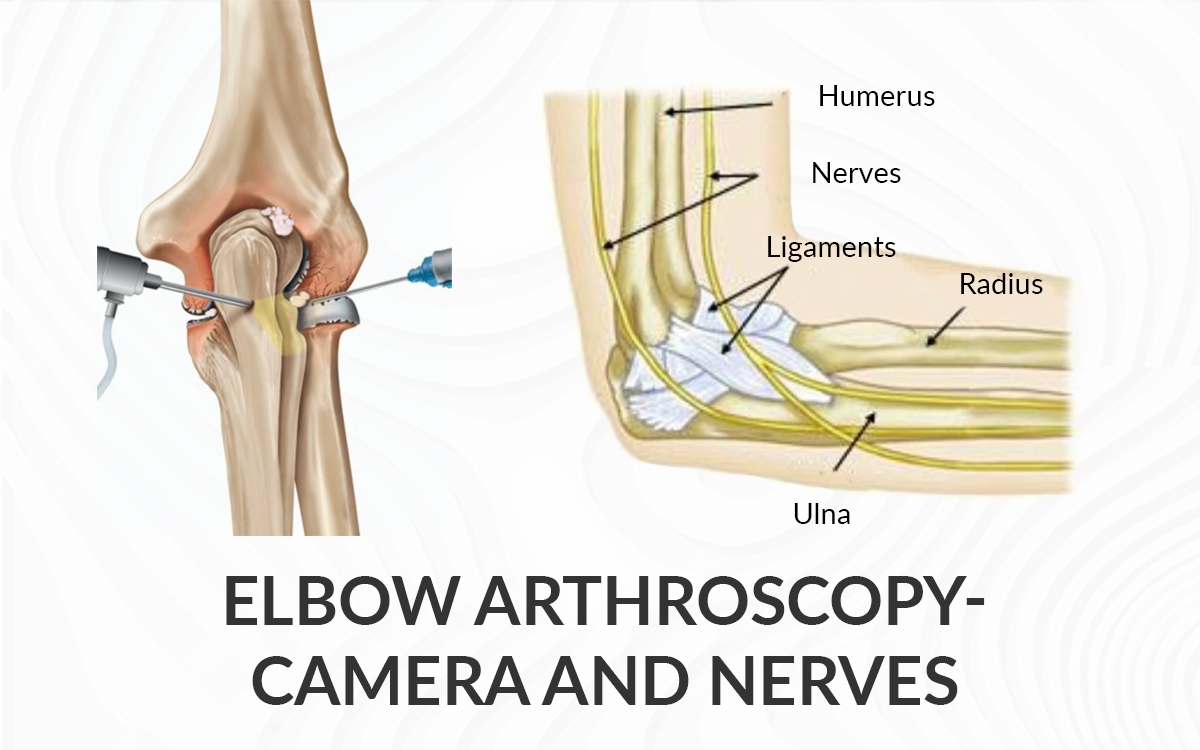
Summary
Elbow Arthroscopy
- Minimally invasive technique
- Involves the use of a tiny camera ( arthroscope )
Undertaken to
- Remove any loose bodies
- Remove any loose bits of cartilage or bone
- Do a tennis elbow release
Benefits
- Improves any stiffness in the elbow
- Reduce any pain
- Give more range of motion
Details of surgery
- Day care procedure
- General anaesthesia
- Lasts roughly 30-45 minutes
What is an Arthroscopy?
Arthroscopy is a procedure that allows orthopaedic surgeons to inspect, diagnose and repair problems inside a joint. The word arthroscopy comes from two Greek words, Arthro (joint) and skopein (to look). Arthroscopy literally means to look within the joint.
During an arthroscopy your surgeon will insert a small camera called an arthroscope into your elbow joint. The camera will then display pictures on a screen and your surgeon will use these images to guide surgical instruments, inspect and repair the problem.
What is an Elbow Arthroscopy?
Elbow arthroscopy is a minimally invasive technique to diagnose and treat a range of conditions affecting the elbow joint. As in other joints like shoulder and wrist, arthroscopy of elbow involves the use of a tiny camera ( arthroscope ) that is inserted through small incisions or portals around your elbow.
Why should I have an Elbow Arthroscopy (indications )?
The benefits of having an elbow arthroscopy is to improve any stiffness that you may have in your elbow, to remove any loose bodies, to remove any loose bits of cartilage or bone and to do a tennis elbow release. The aim is to reduce any pain and give you more range of motion and hence a normal function to your elbow.
What are the risks?
In general like with any surgery, risks relate to the anaesthesia and the procedure itself. On the day of your surgery you will be seen by your anaesthetist who will discuss the anaesthetic risks with you. Surgical risks include infection, damage to nerves, bleeding, stiffness of the elbow, recurrence or persistence of symptoms and the need for further surgical interventions.
Is Elbow Arthroscopic surgery a major surgery?
It is a major surgical procedure with the highest rate of complication amongst all the arthroscopic surgeries in the musculoskeletal system. It will require an appropriate postoperative rehabilitation.
Is Elbow Arthroscopy a day surgery?
It is often a day surgery. You may have some pain in the joint after surgery. You will be sent home with pain medication.
What will happen on the day of surgery?
You will be seen by an anaesthetist who will discuss anaesthetic complications with you. Your surgeon will take you through the consent process. Once you are in the operating room you will be given antibiotics and general anaesthesia.
Surgery involves making several cuts around your elbow from which the camera and arthroscopic instruments are inserted. An assessment is then made of the relevant structures inside the elbow joint. Then depending on the indication for the arthroscopy, treatment is done like removal of loose bodies, removal of any bits of bone or cartilage, release of capsule, tennis elbow release etc.
At the end the skin portals will be stitched up and you will come out into recovery in a bulky dressing and a sling. In my practice, tennis elbow is the most common indication for which I would offer my patients elbow arthroscopy.
What do I need to do after I go home?
You will be sent home in a sling and with pain medications. You would have seen a physiotherapist before leaving hospital who will teach you elbow range of motion exercises and discuss further rehabilitation with you.
You should leave the dressing dry. Bulky dressing comes off in 2 days. You will then be seen by your consultant in 2 weeks’ time for further inspection of wound and removal of stitches. Depending on the nature of surgery you can drive around 3-4 weeks. You may have to limit your activity for 6-8 weeks to allow your elbow strength and movement to return to normal. Your elbow will improve within 6-9 months.
BMI Chelsfield Park Hospital
Bucks Cross Road Chelsfield ORPINGTON BR6 7RG
01689 877855
BMI The Blackheath Hospital
40-42 Lee Terrace Blackheath LONDON SE3 9UD
020 8318 7722
BMI The Sloane Hospital
125 Albemarle Road BECKENHAM BR3 5HS
020 8466 4000
Princess Royal University Hospital
Farnborough Common ORPINGTON BR6 8ND
01689 863223




